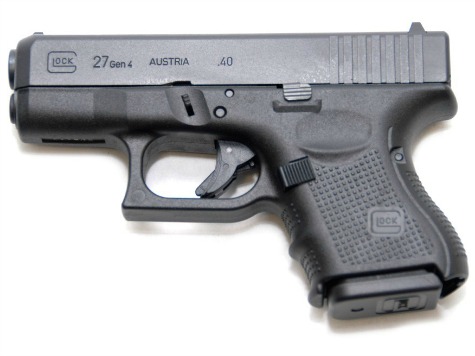
The 9mm is a great round, and in my last concealed carry post I covered some great concealed carry guns built around that caliber.
However, there are a lot of handguns in larger calibers that are perfect for concealed carry as well — that are also designed for concealed carry — and these guns carry the benefit of having more knock down power, or more one-shot stopping power.
Specifically, I’m thinking about handguns chambered in .40 and .45 caliber.
To cover these rounds, I’m going to examine the Glock 27 in .40, the Smith & Wesson M&P in .45, and the Springfield XDS in .45.
Let’s begin with the Glock 27.
Just as I wrote concerning the Glock 26 in an earlier post, the Glock 27 is as close to handgun perfection as mankind can witness in this world. It is compact, unbelievably durable, and it shoots any kind of factory-loaded ammo you want to put through it.
Like the Glock 26 in 9mm, the Glock 27 in .40 provides great second shot accuracy for those who take the time to practice, practice, practice. Unlike the 26, the model 27 shoots the potent .40 cal round. This round is very popular with federal agencies and police departments and is a concealed carry staple because of its raw stopping power.
For anyone unfamiliar with the .40 cal round, it is slightly more expensive to buy than 9mm, but not significantly so. And plus-P hollow points in .40 cal are simply a force to be reckoned with.
The Glock 27 comes standard with two 9 round magazines, and it’s so popular that accessories galore — holsters, lights, lasers, etc. — are readily available for it.
Now to the Smith & Wesson M&P .45.
Folks, this is a serious gun. For the longest time, Smith & Wesson was known for making outstanding revolvers — which they still do — but their semi-autos largely consisted of guns popular with police departments, while their civilian-level weapons simply weren’t on par with Glock, Sig Sauer, etc. The M&P line of semi-automatic handguns has changed all that.
The M&P .45, which comes in standard or compact size, is as good as they get. It has a safety integrated into the trigger (like a Glock), and is available with an additional thumb release safety on the slide.
This gun is deadly accurate. I bought one of the first M&Ps carried in the gun store in my neighborhood, and after I shot it I went back and asked the store owner, “Have you shot one of these?” I went on to tell him that it was one of the most accurate, easy-to-shoot .45 caliber weapons I’d ever fired.
That was a few years ago and it still holds true.
Is the M&P as durable as Glock? They haven’t been around as long as Glocks, so time will tell. My guess, however, is that the stamp on the side of the gun that says “Smith & Wesson” means you can bet your bottom dollar this gun is going to last longer than you are.
On to the Springfield XDS .45.
The XDS .45 is the newest of the three guns reviewed here. It is a single stack pistol, which means the magazine is narrow and the bullets stack one directly on top of another when you load them in.
In a double stack pistol like the Glock or the Smith & Wesson M&P, the bullets over lap slightly when you put them into the magazine, but they are offset so that you can get more bullets in. This makes the magazine wider, and thus the gun wider as well. The single stack magazine means the XDS is very slim — and therefore very concealable — even though the .45 is such a big round.
Because of this, when you pick up an XDS you think it must be a .380 or perhaps even a compact 9mm. You are shocked to find out it is a .45
To maintain the small, concealable size of the XDS, it only hold 5 rounds (standard) or 7 rounds (extended mag). Those familiar with a .45 know that 5 to 7 rounds of .45 is still a lot of firepower, and in a matter of life and death the XDS is an easier pistol to have with you than some larger pistols are.
One suggestion: If you go with the XDS, shoot it over and over and over again in practice; because of it’s size, the recoil is significant. This is not a negative — it’s just a characteristic of this handgun which you have to take into account if it’s going to be your carry gun.

COMMENTS
Please let us know if you're having issues with commenting.